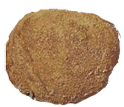 Paqua in the
Bible
Paqua in the
Bible
Is it a truffle or a mushroom?
 The word ‘paqua’ is derived from the root
‘pqa’ which in its verb form means ‘to
emerge’. In Hebrew
and in the Arabic of the area, the word ‘paqua’ (or
‘fuqa’) is used to refer to fungi in general as
well as to truffles. This word is found in the Bible, in 2 Kings,
chapter 4, 39-42, in a story about a miracle performed by the prophet
Elisha (Eliseus). The story takes place in the Kingdom of Israel,
around 900 B.C.E., not long after the death of King Ahab, but it was
probably written hundreds of years later. In the story, the prophet
Elisha is asked to feed a large number of people at a time of severe
drought which cause famine in the land. He sends someone to the field
to collect anything that could be cooked. The person finds some kind of
creeping plant and collects a good amount of “paquot
sade”, translated “paquot of the field”
(‘paquot’ is the plural form of
‘paqua’) from around it. In biblical Hebrew the
word “mimenu” can be used as ‘from
it’ and ‘from right next to it’.
Apparently the man does not have a basket to carry the paquot in, so he
lifts the flap of his robe and uses it to carry them back to camp. Once
back at camp, he slices (or cubes) the paquot, and adds
them to the cooking soup. The people who eat the soup call out in
horror, “there is death in the pot!” The prophet
Elisha throws some flour or powder into the pot, thus rendering the paquot soup safe to
eat.
The word ‘paqua’ is derived from the root
‘pqa’ which in its verb form means ‘to
emerge’. In Hebrew
and in the Arabic of the area, the word ‘paqua’ (or
‘fuqa’) is used to refer to fungi in general as
well as to truffles. This word is found in the Bible, in 2 Kings,
chapter 4, 39-42, in a story about a miracle performed by the prophet
Elisha (Eliseus). The story takes place in the Kingdom of Israel,
around 900 B.C.E., not long after the death of King Ahab, but it was
probably written hundreds of years later. In the story, the prophet
Elisha is asked to feed a large number of people at a time of severe
drought which cause famine in the land. He sends someone to the field
to collect anything that could be cooked. The person finds some kind of
creeping plant and collects a good amount of “paquot
sade”, translated “paquot of the field”
(‘paquot’ is the plural form of
‘paqua’) from around it. In biblical Hebrew the
word “mimenu” can be used as ‘from
it’ and ‘from right next to it’.
Apparently the man does not have a basket to carry the paquot in, so he
lifts the flap of his robe and uses it to carry them back to camp. Once
back at camp, he slices (or cubes) the paquot, and adds
them to the cooking soup. The people who eat the soup call out in
horror, “there is death in the pot!” The prophet
Elisha throws some flour or powder into the pot, thus rendering the paquot soup safe to
eat.
Based on the Vulgate translation and subsequent biblical interpretations of the verses, it is thought that the creeping plant next to which the paquot were collected is a local bitter melon from the Citrullus family, perhaps Citrullus colocynthis. The word Paqua was translated to mean the fruit of the wild bitter Citrullus plant. Citrullus colocynthis was not considered a possible host in a mycorrhizal relationship with a desert truffle.
From the context of this story it is clear that it takes place in spring, which is when desert truffles produce fruitbodies, but when species of Citrullus are in bloom. And then a few years ago Prof. Varda Kagan-Zur of the Beer Sheva University in the Negev, discovered that the desert truffle Terfezia pfeilii forms mycorrhizal relations with …a member of the Citrullus family (Citrullus vulgaris)!
The term paqua has been used to refer to truffles and mushrooms all over the Middle East since antiquity. It seems strange to accept that paqua refers to a different object only in this story, while referring to desert truffles and mushrooms before, during, and after the story took place, and until the present day. It seems that the story in 2 King 4:39-42 should be declared the first description of mushroom poisoning with a happy ending!